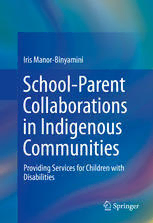
School-Parent Collaborations in Indigenous Communities: Providing Services for Children with Disabilities PDF
Preview School-Parent Collaborations in Indigenous Communities: Providing Services for Children with Disabilities
Iris Manor-Binyamini School-Parent Collaborations in Indigenous Communities Providing Services for Children with Disabilities School-Parent Collaborations in Indigenous Communities Iris Manor-Binyamini School-Parent Collaborations in Indigenous Communities Providing Services for Children with Disabilities Iris Manor-Binyamini Department of Special Education University of Haifa Haifa , Israel ISBN 978-1-4614-8983-2 ISBN 978-1-4614-8984-9 (eBook) DOI 10.1007/978-1-4614-8984-9 Springer New York Heidelberg Dordrecht London Library of Congress Control Number: 2013951814 © Springer Science+Business Media New York 2014 This work is subject to copyright. All rights are reserved by the Publisher, whether the whole or part of the material is concerned, specifi cally the rights of translation, reprinting, reuse of illustrations, recitation, broadcasting, reproduction on microfi lms or in any other physical way, and transmission or information storage and retrieval, electronic adaptation, computer software, or by similar or dissimilar methodology now known or hereafter developed. Exempted from this legal reservation are brief excerpts in connection with reviews or scholarly analysis or material supplied specifi cally for the purpose of being entered and executed on a computer system, for exclusive use by the purchaser of the work. Duplication of this publication or parts thereof is permitted only under the provisions of the Copyright Law of the Publisher’s location, in its current version, and permission for use must always be obtained from Springer. Permissions for use may be obtained through RightsLink at the Copyright Clearance Center. Violations are liable to prosecution under the respective Copyright Law. The use of general descriptive names, registered names, trademarks, service marks, etc. in this publication does not imply, even in the absence of a specifi c statement, that such names are exempt from the relevant protective laws and regulations and therefore free for general use. While the advice and information in this book are believed to be true and accurate at the date of publication, neither the authors nor the editors nor the publisher can accept any legal responsibility for any errors or omissions that may be made. The publisher makes no warranty, express or implied, with respect to the material contained herein. Printed on acid-free paper Springer is part of Springer Science+Business Media (www.springer.com) To my parents, Michael (of blessed memory) and Noga Manor To my husband and children Without your support this book would not have been written “ Inspiration , whatever its nature , is born of a perpetual ‘ I don ’ t know ’. Any knowledge that doesn ’ t give rise to new questions quickly expires : it lacks the vital warmth that sustains life ” (Wisława Szymborska, In Praise of Dreams . Tel Aviv: Attention to Poetry 2004, page 163). I sincerely hope that this book raises many questions for readers, thus ensuring that this important issue does not expire quickly or lose its vital sustenance. Pref ace Indigenous peoples across the world have other stories to tell (Smith L.T., 1999) Indigenous people are just as much a part of the complex modern world as any of us; they may be different, they may be unique, but they must be nurtured, respected, and allowed to emerge. This is particularly pertinent in regard to children with disabilities, in light of the fact that worldwide, minorities are overrepresented in populations of people with disabilities. In some areas of the world, the disability rate among indigenous peoples is more than double the rate in the non-indigenous population (see Chap. 2 for specifi c data). Indigenous populations collaborating with the parents of children with disabilities are a prerequisite for treatment to prove effective; hence, the subject of this book is of paramount importance. There are seven chapters in the book, some informative and some practicable. Chapters 1 – 4 provide the background, bringing the reader up to date on the relevant professional literature and terminology, and review the current state of several indigenous communities worldwide. Chapters 5 – 7 take an in-depth look, through the case studies presented, at the Bedouin community in the Negev desert in Israel, and examine the collaboration between professionals and parents of children with disabilities in this community. The following is a detailed description of the chap- ters in the book. Chapter 1 The fi rst chapter, which opens the book, is the backdrop for the entire book; in this chapter, I present the common characteristics unique to indigenous communities and to children with disabilities in these communities. It opens with a defi nition of indigenous peoples, and presents the world’s indigenous population numbering about 257–350 million people. Later in the chapter, I survey the attempt to explain the source of the diffi culties and challenges common to all indigenous communities ix
